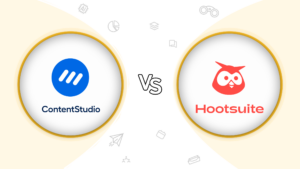Loomly vs Buffer
Loomly vs Buffer – What’s Better For You in 2025?
Which tool is the best? Is it that hard to decide?
If you're stuck between Loomly and Buffer, you're not alone. Both offer great features, but the right choice depends on your needs.
No credit card required

Quick Summary: Loomly and Buffer
When deciding on the perfect social media management tool, certain aspects, such as features, pricing, reviews, and support, must be evaluated.
Here is the overview of tools:
2 months free with annual billing
Loomly Overview
Loomly, founded in 2015, currently has more than 50,000 employees. Loomly is a social media management platform designed to help agencies plan, create, schedule, and publish content across multiple channels from a single dashboard. It supports collaboration with clients and teams through features like approval workflows and separate dashboards per client, which helps reduce back-and-forth and keeps things organized.
The tool also offers content inspiration tools (like post ideas and RSS feed integrations), analytics and reporting, and a shared content library to streamline branding and asset reuse.
Users on Capterra appreciate Loomly for its clean interface, easy scheduling, and robust calendar that simplifies multi-platform posting. Many also highlight its affordability compared to competitors and praise its fast, responsive customer support. However, some reviewers point out limitations like incomplete Instagram integration and the lack of advanced editing features, which can be inconvenient for teams needing more depth. (Capterra)
Users find Loomly to be extremely user-friendly, simplifying post scheduling and management across multiple social accounts. Some users find the scheduling posts issue frequent, and the lack of recurring posts and tailored time slots per channel makes it difficult for them to operate the tool seamlessly. (G2)
Buffer Overview
Buffer was started in 2010. Buffer is a social media management tool built to help agencies schedule, publish, analyze, and engage with content across multiple social platforms from one central dashboard. It offers features like customizable posting schedules, draft & approval workflows, and user permissions so teams and clients can collaborate with clarity.
Buffer also provides analytics dashboards and reporting that help agencies track engagement, reach, follower growth, and campaign performance to make data-driven decisions.
Students and professionals highlight Buffer’s simplicity, effective content queue management, and responsive support. A few notes, the platform can feel limited for Pinterest- or visual-first strategies. (Capterra)
Users appreciate Buffer’s reliable multi-platform scheduling, clean interface, and team collaboration tools. Many highlight its broad channel support and user-friendly analytics, although some wish for deeper visual-posting features. (G2)
Rating Comparison
Feature Comparison: Loomly vs Buffer
Features
Scheduling & Publishing
Schedule posts across multiple channels, including a drag-and-drop calendar and an overview of upcoming posts.
Queue-based scheduler with calendar view; supports Threads, Mastodon, Instagram, TikTok, and more.
AI-powered scheduler recycles evergreen content, auto-schedules posts, and suggests best times to publish.
Engagement
Responds to comets, messages, and mentions across all connected channels.
Manages and responds to comments and messages from one place.
Unified inbox helps reply faster; smart filters prioritize conversations that need attention.
Collaboration
Approval workflow, user roles, custom roles, and workflows
Add internal comments to your content, role-based workflow, and reply to comments and messages on their connected social media profiles.
Shared workspaces and approval flows keep teams aligned with role-based access and smart task routing.
Analytics
Custom dashboard provides deep insights and reports for all connected platforms
Custom reports, audience insights, Audience demographics, and branded reports.
Smart analytics track engagement, reach, and clicks; white-label reports simplify client performance tracking.
AI Features
AI assistant generates a caption based on a prompt.
AI assistant writes captions, generates hashtags, and improves clarity
Generates captions, hashtags, bios, and post ideas; predicts performance; automates scheduling and reports.
Pros & Cons: Loomly and Buffer
Pros
- Manage multiple accounts from one dashboard.
- Visual Content calendar for easy planning.
Cons
- No evergreen recycling.
- Lacks deeper cross-platform analytics.
Pros
- An AI caption generator from a prompt.
- Generates customised and branded reports
Cons
- No AI image generator.
- Custom access and permissions only for enterprise-level plans.
Pricing Comparison
Starter
1 user and 10 social accounts, ideal for small businesses.
Essentials
5 channels, 1 user account, and up to 10 social media profiles
Starter
2 social profiles, 10 daily posts, 5 recurring time slots
Advanced
10 users, 20 social accounts, and more advanced features
Team
5 channels, unlimited user accounts, and up to 10 social media profiles.
Personal
5 social profiles, 20 daily posts, 10 recurring time slots
Agency
unlimited users, 35 social accounts, and premium features
Agency
20 social profiles, 80 daily posts, 40 recurring time slots
Why RecurPost Stands Out
If you’re looking for better service and tired of underwhelming tools, RecurPost can give you the edge you need. No matter if you are looking for a tool under a tight budget or an advanced analytical tool with real-time customer support, RecurPost checks all the boxes. If you’re someone who believes in working smarter, not harder, then your goals already align with ours. From efficient team collaboration to meeting client deadlines or simply managing your own social media presence, RecurPost makes it effortless. And with a minimal learning curve, it’s beginner-friendly too.
Need a personal assistant for every other chore? Consider it done- at least for your social media. RecurPost’s AI Assistant gives you the ultimate power to generate captivating captions and eye-catching images from a single prompt. CSV uploader lets you plan dozens of images and videos for your social media feed and schedule them too. Branded, customized reports are included as a standard feature, right from our entry-level pricing.
Seasonal and event libraries, Instagram grid planner, automated DM workflows, agency pricing calculator, white-label reports and proposal templates, and free templates & eBooks for data-driven growth are all the extra privileges.
Why RecurPost is better!
RecurPost isn’t just an alternative to Loomly and Buffer – it’s a smarter choice for businesses that want more functionality at a lower cost.






